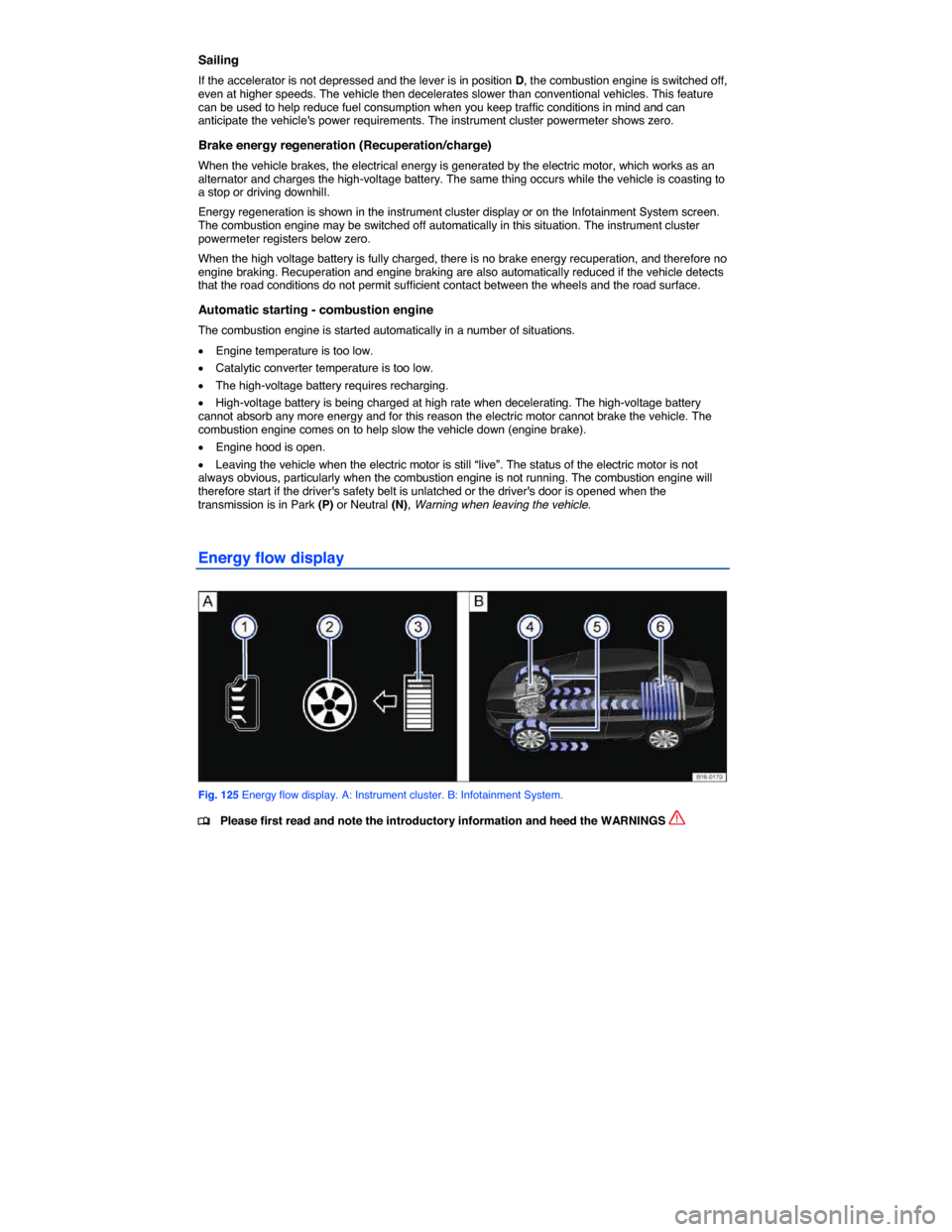Page 211 of 372
Remove all unnecessary items and unnecessary dead weight from the vehicle.
Remove unnecessary aftermarket components
The more aerodynamic the vehicle, the less fuel it will consume. Aftermarket components such as bicycle racks reduce its aerodynamic performance.
Therefore, remove unnecessary structures and unused rack systems, particularly if planning to drive at higher speeds.
See, Hybrid drive for additional tips on using your hybrid drive to help reduce fuel consumption.
Page 217 of 372
Driving situations Requirements and conditions Vehicle behavior
Driving in city traffic. – Select a moderate speed. Driving in fully electric mode at this level is possible with a constant speed of up to about 37 mph (60 km/h) on a flat road surface
– Avoid full acceleration. The fuel consumption is reduced with moderate acceleration due to higher efficiency of the combustion engine and driving in fully electric mode is possible.
– Careful use of the �%�
Page 220 of 372

Sailing
If the accelerator is not depressed and the lever is in position D, the combustion engine is switched off, even at higher speeds. The vehicle then decelerates slower than conventional vehicles. This feature can be used to help reduce fuel consumption when you keep traffic conditions in mind and can anticipate the vehicle's power requirements. The instrument cluster powermeter shows zero.
Brake energy regeneration (Recuperation/charge)
When the vehicle brakes, the electrical energy is generated by the electric motor, which works as an alternator and charges the high-voltage battery. The same thing occurs while the vehicle is coasting to a stop or driving downhill.
Energy regeneration is shown in the instrument cluster display or on the Infotainment System screen. The combustion engine may be switched off automatically in this situation. The instrument cluster powermeter registers below zero.
When the high voltage battery is fully charged, there is no brake energy recuperation, and therefore no engine braking. Recuperation and engine braking are also automatically reduced if the vehicle detects that the road conditions do not permit sufficient contact between the wheels and the road surface.
Automatic starting - combustion engine
The combustion engine is started automatically in a number of situations.
�x Engine temperature is too low.
�x Catalytic converter temperature is too low.
�x The high-voltage battery requires recharging.
�x High-voltage battery is being charged at high rate when decelerating. The high-voltage battery cannot absorb any more energy and for this reason the electric motor cannot brake the vehicle. The combustion engine comes on to help slow the vehicle down (engine brake).
�x Engine hood is open.
�x Leaving the vehicle when the electric motor is still “live”. The status of the electric motor is not always obvious, particularly when the combustion engine is not running. The combustion engine will therefore start if the driver's safety belt is unlatched or the driver's door is opened when the transmission is in Park (P) or Neutral (N), Warning when leaving the vehicle.
Energy flow display
Fig. 125 Energy flow display. A: Instrument cluster. B: Infotainment System.
�
Page 226 of 372

�x Switch on the ignition.
�x Switch on the Infotainment system, if necessary.
�x Press the CAR Infotainment button.
�x Tap a function key on the screen to view the information described below.
Function key Function
Driv. data Since Start Display of average fuel consumption, average speed, route, travel time, and range from the time the ignition was switched on until the time it was switched off.
Long-term Display of average fuel consumption, average speed, route, travel time, and range.
Hybrid Energy flow Shows the energy flow between the engine, high-voltage battery, and driving wheels
Zero Emission Displays the emission-free driving time as a bar graph. Each bar represents 1 minute of driving. The height of the bar indicates the proportion of emission-free driving in %.
A full bar, or 100% ⇒ fig. 129 (1), is a 1 minute interval of emission-free hybrid driving or sailing. No bar, or 0% (2), is a 1 minute interval driving only with the combustion engine. The display shows the emissions for a maximum of 30 minutes. Tapping Reset resets all values on this graph to zero.
You can always go back to the previously active menu by pressing the �
Page 313 of 372
Lights up Possible cause Proper response
�B
Engine control/monitoring system malfunction (engine Malfunction Indicator Light - MIL)
Ease off the accelerator. Carefully drive to the nearest authorized Volkswagen dealer or authorized Volkswagen Service Facility. Have engine checked.
Flashes Possible cause Proper response
�B Misfire, which can damage the catalytic converter.
Ease off the accelerator. Carefully drive to the nearest authorized Volkswagen dealer or authorized Volkswagen Service Facility. Have engine checked.
When the ignition is switched on, several warning and indicator lights come on briefly for a function check. They go out after a few seconds.
NOTICE
Failure to heed warning lights or text WARNINGS can result in vehicle damage.
As long as the indicator lights x or EPC are on, expect engine malfunctions, increased fuel consumption, and loss of engine efficiency.
Catalytic converter
�